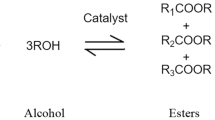Abstract
Reducing fuel consumption in automotive engines is a key enabler for CO2 emission reduction. Tribology plays a significant role in reducing parasitic losses in an engine and thus reducing fuel consumption. The paper reviews frictional losses in critical engine components and the lubrication regime(s) they operate. This reveals the opportunities for friction reduction at cylinder bore/piston contact, valvetrain, and bearings through deposition of low friction coatings, improved surface finish, surface modifications, and low friction engine oil. The paper also attempted to capture implementation of some of these friction reduction concepts in recent engines.













Similar content being viewed by others
References
Pinkus O, and Wilcock D F, Strategy for energy conservation through tribology, ASME, New York (1977).
Kiovsky T E, Yates N C, and Bales J R, Lub Eng 50 (1994) 307.
Gangopadhyay A K in chapter contribution to Coating Technology for Vehicle Applications, (ed) Cha S C, and Erdemir A, Springer, New York (2015), p 63.
Matz M M, and Kennedy M, Therm Spray Bull 4 (2011) 20.
Martínez D L, Valverde M, Rabuté R, and Ferrarese A, MTZ 71 (2010) 26.
Wakabayashi R, Mochiduki K, and Yoshida H, SAE paper no. 2009-01-0188 (2009).
Paulo J R, Mordente P J R, and Bruno R A, SAE paper no. 2009-36-0128 (2009).
Kennedy M, Hoppe S, and Esser J, MTZ, 73 (2012), 40.
Kennedy M, Hoppe S, and Esser J, MTZ, 75 (2014), 25.
Aiyoshizawa E, and Hori K, Internationales Wiener Motorensymposium, 35 (2014)
Frommer A, Deuß T, Ehnis H,and Künzel R, MTZ 77 (2016) 48.
Gand B, MTZ, 72 (2011) 34.
Morawitz U, Mehring J, and Schamm L, SAE paper no. 2013-01-0292 (2013).
Werner P, Schommers J, Breitbach H, and Spengel C, MTZ 72 (2011) 22.
Steinparzer F, Unger H, Brüner T, and Kannenberg D, Internationales Wiener Motorensymposium 32 (2011).
Hwan, K, Hwang I, Lee H, Park H, Choi H, Lee K, Kim W, Kim H, Han B, Lee J, Shin B, and Chae D, SAE paper no 2016-01-0667 (2016).
Furumata S, Kakinuma T, and Tochiki H, SAE paper no 2016-01-1012 (2016).
Ichikawa H, Nakada N, and Yajima J, SAE paper no 2009-01-1067 (2009).
Galda L, Pawlus P, Sep J, Tribol Int 42 (2009) 1505.
Grabon W, Koszela W, Pawlus P, and Ochwat S, Tribol Int 61 (2013) 102.
Braun D, Greiner C, Schneider J, and Gumbsch P, Tribol Int 77 (2014) 142.
Vladescu S C, Olver A V, Pegg I G, and Reddyhoff T, Tribol Int 82 (2015) 28.
Segu D Z, and Hwang P, Ind Lubr Technol 68 (2016) 116.
Urabe M, Takakura T, Metoki S, Yanagisawa M, and Murata H, SAE paper no. 2014-01-1661 (2014).
Hua X, Sun J, Zhang P, Ge H, Fu Y, Ji J, and Yin B, Tribol Int 98 (2016) 190.
Howell-Smith S, Rahnejat H, King P D, and Dowson D, Proc Inst Mech E Part D J Automobile Eng 228 (2014) 391.
Golloch R, Merker G P, Kessen U, and Brinkmann S, in 14th International Colloquium Tribology, Jan 13–15 (2004), Tribology and Lubrication Engineering, (ed) Wilfred Bartz, Vol 1.
Witzenburg G, Wards Auto, June 15, (2016).
Ando S, and Takashima K, Internationales Wiener Motorensymposium 37 (2016).
Hill S H, Kantola T C, BrownJ R, and Hamelink J C, SAE paper no 950938 (1995).
Deuss T, Ehnis H, Freier R, and Kunzel R, MTZ 71 (2010) 7.
Kim Y, Park H, and An J-U, SAE paper no 2011-01-1401 (2011).
Suzuki N, and Hikasa A, SAE paper no 2012-32-0090 (2012).
Birch S, Automotive Engineering Online, September 16 (2010).
Ogihara H, SAE paper no 2005-01-1647 (2005).
Witzenburg G, Wards Auto, Apr 1, (2013).
Press release, http://investor.federalmogul.com/phoenix.zhtml?c=97066&p=irol-newsArticle_Print&ID=1449403&highlight=, July 20, 2010.
Hanke W, Ando H, Fahr M, and Voigt M, MTZ 75 (2014) 26.
Adam A, Prefot M, and Wilhelm M, MTZ, 71 (2012) 22.
Schreer K, Roth I, Schneider S, and Ehnis H, in Proceedings of the ASME 2013 Internal Combustion Engine Division Fall Technical Conference ICEF2013 October 13–16, 2013, Dearborn, Michigan, USA.
Kwang-soo Kim K-S, Shah P, Takiguchi M, and Aoki S, SAE paper no 2009-01-0193 (2009).
Shimada Y, Abou S, Okita K, and Chuubachi M, SAE paper no 2006-01-0618 (2006).
Witzenburg, G, Wards Auto, Apr 1, (2013).
Gangopadhyay A K, McWatt D G, Zdrodowski R J, Simko S J, Matera S, Sheffer K, and Furby R S, Tribol Trans 55 (2012) 99.
Mabuchi Y, Hamada T, Izumi H, Yasuda Y, and Kano M, SAE paper no 2007-01-1752 (2007).
http://www.nissan-global.com/EN/NEWS/2006/_STORY/060822-01-e.html, August 22, 2006.
Crabb D, Fleiss M, Larsson J-E, Somhorst J, MTZ 74 (2013) 4.
Okuda S, Dewa T, and Sagawa T, SAE paper no 2007-01-1979 (2007).
Shinyoshi T, Fuwa Y, and Ozaki Y, SAE paper no 2007-01-1969 (2007).
Haque T, Morina A, Neville A, Kapadia R, and Arrowsmith S, Tribol Int 40 (2007) 1603.
Vengudusamy B, Greene J H, Lamb G D, and Spikes H A, Tribol Int 54 (2012) 68.
Keunecke M, Bewilogua K, Becker J, Gies A, and Grischke M, Surf Coat Technol 207 (2012) 270.
Tiermann C, Kalenborn M, Orlowsky K, Steffens C, and Bick W, MTZ, 68 (2007) 286.
Baubet Y, Pisani C, Carden P, Molenaar L, and Reedman A, SAE Paper Number 2014-01-1637 (2014).
Jacobs, C. Forecast: Changeable, with Rising Pressure. Lubes’N’Greases, 22 (2016).
Author information
Authors and Affiliations
Corresponding author
Rights and permissions
About this article
Cite this article
Gangopadhyay, A. A Review of Automotive Engine Friction Reduction Opportunities Through Technologies Related to Tribology. Trans Indian Inst Met 70, 527–535 (2017). https://doi.org/10.1007/s12666-016-1001-x
Received:
Accepted:
Published:
Issue Date:
DOI: https://doi.org/10.1007/s12666-016-1001-x




